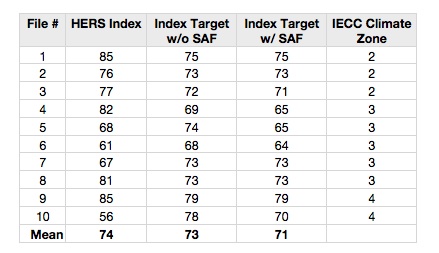ENERGY STAR Homes Version 3 – Lowering the HERS Index

Last week I got the new version of REM/Rate, the accredited home energy rating software that we use here at Energy Vanguard Energy Ratings, and it has the ENERGY STAR Version 2.5 and Version 3 requirements built in. I’ve checked a few files with it now, and it looks like the new requirements make a pretty big improvement in the HERS Index required for a home to qualify for the ENERGY STAR label.
Last week I got the new version of REM/Rate, the accredited home energy rating software that we use here at Energy Vanguard Energy Ratings, and it has the ENERGY STAR Version 2.5 and Version 3 requirements built in. I’ve checked a few files with it now, and it looks like the new requirements make a pretty big improvement in the HERS Index required for a home to qualify for the ENERGY STAR label.
In my first report on the ENERGY STAR Version 3 guidelines, I discussed the individualized HERS Index targets that a home would have to meet to qualify for the ENERGY STAR. Since 2006, most of the country has had to come in at or lower than a HERS Index of 85, including IECC climate zones 2, 3, and 4, where most of our raters are. In the coldest parts of the US, the requirement is a HERS Index of 80 or lower.
With Versions 2.5 and 3, each home has its own HERS Index target. As you can see in the table below, the average HERS Index for the 10 homes I sampled (all of which are in climate zones 2, 3, or 4) is 73 before applying the Size Adjustment Factor (SAF).

Notice that, based only on the HERS Index, all of these homes qualify in Version 2, but only 3 qualify in Version 3. The new HERS Index target goes into effect with Version 2.5, which applies to all homes permitted starting at the beginning of 2011. (See my article on the recent ENERGY STAR training I went to for the timeline showing when to use Version 2, 2.5, or 3.)
SAF in the table stands for Size Adjustment Factor, which is the penalty that houses have to pay when they go above the benchmark home size. Of the homes above, 5 were above the benchmark size, and thus had to meet a lower HERS Index to qualify, as indicated in the fourth column. The benchmark home size is the maximum size allowed without penalty for a house with a given number of bedrooms, shown in the table below.
![]()
As you can see, homes will definitely have to be more energy efficient to qualify for the ENERGY STAR homes label in Version 3 of the program. This requirement kicks in with Version 2.5, which applies to all homes permitted in 2011, as well as those permitted before 2011 but finished after 1 July 2011. Grade I insulation installation and reduced thermal bridging are two of the ways that homes will have to improve, both of which are required in Version 3.
Download our free 16 page white paper by clicking the link below:
This Post Has 4 Comments
Comments are closed.


Allison, the following is
Allison, the following is from the ES 2011 FAQ dated April 2009.
“The proposed performance path provides the opportunity to more accurately associate the ENERGY STAR 2011 threshold with homes… that are roughly equivalent to homes 35 percent more efficient than the 2006 IECC.”
Does this mean ES v3 is pegged to the 2006 IECC? And what about the 35% number? This appears inconsistent with the index targets (pre-SAF) you came up with.
David, that 35% must be based
David, that 35% must be based on the ENERGY STAR team’s initial look at the impact of the new requirements on energy efficiency. It’s averaged over all climate zones, I’m sure, and that may represent the difference between the their 35% and my 27%. Although my sample size is fairly low, the 99% confidence level would be 73±3, not big enough to include their 35%.
ES V3 is actually tied to both the 2009 IECC and the 2006 (or 2004) IECC. The former is referenced in the new guidelines as being the minimum that homes must reach in each area. The latter comes in with the HERS Index, which is based on the HERS Reference Home as defined in the 2006 HERS Standards. The Reference Home is based on the 2004/2006 IECC.
I’ve posted my article in a few places on LinkedIn and Home Energy Pros with the hope of getting input from people in other climate zones.
Does the volume enclosed by
Does the volume enclosed by the attic come into these calculations? I have been looking around at homes in the Midland, TX area and most of the older homes have low-peaked roofs, and most of the newer homes have high-peaked roofs. Are there building-science-related pros and cons for attic volume, or is that merely a matter of aesthetics?
Lee, AFAIK, volume has no
Lee, AFAIK, volume has no impact on the HERS score with current version and I haven’t seen anything indicating that’s going to change.
Oh, there is one thing. If you enter infiltration in terms of ACH (bad idea in any case), the program will use the volume you enter to convert to CFM. If the house is tight, even that won’t affect the index unless you’ve select a mechanical ventilation system.